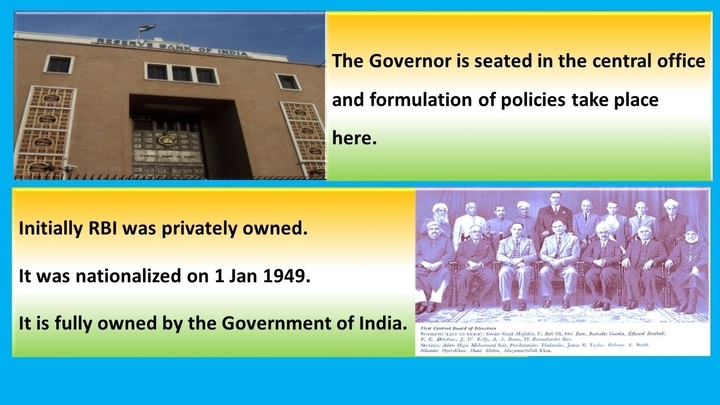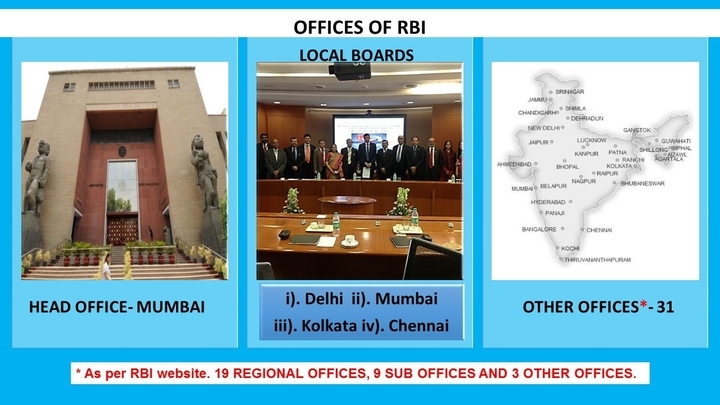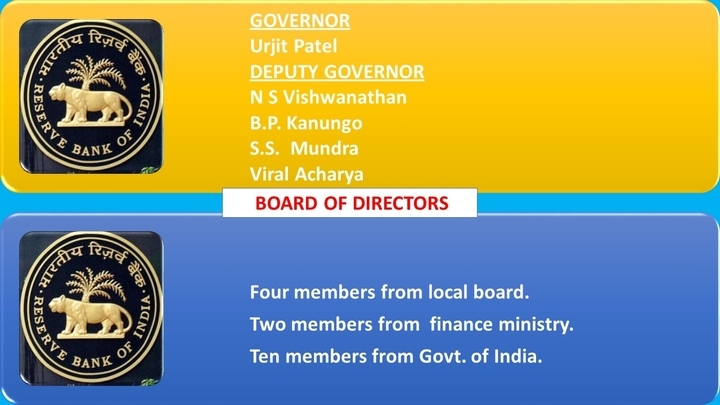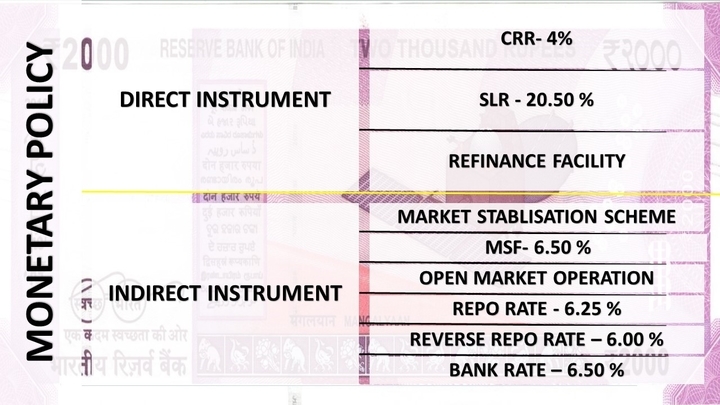Economics Notes on Role of RBI for SSC Exam

we are providing economics notes on the role of RBI for SSC Exam. This topic is important for both SSC CGL and Banking exams. In competitive exams economics plays a vital role. Go through this article for better understanding of role of Reserve Bank Of India.
Role and Functions of Reserve Bank of India
The Reserve Bank of India (RBI) is one and only India's central bank, which controls the demand and supply of the Indian rupee.
It started its operations on 1st April 1935 under the British Rule with the provisions of the Act of Reserve Bank of India Act in the year 1934.
The original share capital was divided into shares of 100 each fully paid, which were under the ownership of private shareholders. RBI was nationalized on 1st January 1949.
The RBI plays an important part in the strategically developing the Government of India. RBI consists of 21-member Central Board of Directors including Governor, there are 4 Deputy Governors, 2 Ministry representatives from finance, 10 government-nominated directors, and 4 directors are appointed to represent local boards which have its headquarters at Mumbai, Kolkata, Chennai and the capital, New Delhi.
Each of these consists of 5 members who represent regional interests, and the interests of co-operative and indigenous banks. The bank is often referred to by the name Mint Street.
DIAGRAMMATIC REPRESENTATION




Major functions of the RBI are as follows:
Issue of Notes
The Reserve Bank of India has the self-right to issue currency notes. However, Ministry of Finance issues one rupee notes. (question has been asked several times)
Under Section 22 of the Reserve Bank of India Act, RBI has sole right to issue currency notes of various denominations except one rupee notes. The One Rupee note is issued by Ministry of Finance and it bears the signatures of Finance Secretary, while other notes bear the signature of Governor RBI.
Banker to the Government
As banker to the government the Reserve Bank manages the needs and issues of the government in terms of banking.
It has to maintain and operate the government’s deposit accounts.
Its duty is to collect the receipts and makes payments on behalf of the government.
RBI is the member of the IMF (International Monetary Fund) and the World Bank and thus represents the Government of India.
Custody of Cash Reserves of Commercial Banks
The commercial banks have deposits in the Reserve Bank.
Custody of Country’s Foreign Currency Reserves:
The central bank keeps the custody of the country’s reserves of foreign currency and hence enables itself to solve the problem of crisis during deficits.
Lender of the Last Resort:
The commercial banks go to the central bank in times of emergency in order to overcome financial problems and the central bank, in turn, helps out by solving the problem although it might charge a higher rate of interest.
SOME IMPORTANT POINTS
RBI’s most important role is to regulate inflation, especially in a developing nation like India. This is done via a policy known as THE MONETARY POLICY.
Monetary Policy is the process by which the monetary authority of a country controls the supply of money, often targeting an inflation rate or interest rate to ensure price stability and general trust in the currency, economic growth and lower unemployment rate.

Monetary Policy has two major instruments which are shown below- DIRECT AND INDIRECT
CASH RESERVE RATIO(CRR)
The share of net demand and time liability(NDTL) that a bank must maintain with RBI in cash. It is applicable on all scheduled commercial banks. It has no minimum and maximum time limits. No interest is paid by it on RBI. Finally, it is mentioned in the RBI Act 1934 section 42(1).
The share of net demand and time liability(NDTL) that a bank must maintain with RBI in cash. It is applicable on all scheduled commercial banks. It has no minimum and maximum time limits. No interest is paid by it on RBI. Finally, it is mentioned in the RBI Act 1934 section 42(1).
STATUTORY LIQUIDITY RATIO(SLR)
The share of net demand and time liability(NDTL) that a bank must maintain with itself in cash and liquid assets. It is applicable on all banks and financial institutions. Though it has no minimum limit however a maximum limit of 40% is capped on it. Liquid assets include GOLD, BONDS, FOREIGN CURRENCY etc. It is mentioned in the RBI Act 1949 section 24.
The share of net demand and time liability(NDTL) that a bank must maintain with itself in cash and liquid assets. It is applicable on all banks and financial institutions. Though it has no minimum limit however a maximum limit of 40% is capped on it. Liquid assets include GOLD, BONDS, FOREIGN CURRENCY etc. It is mentioned in the RBI Act 1949 section 24.
LIQUIDITY ADJUSTMENT FACILITY
An instrument of the RBI which helps banks to adjust their daily liquidity mismatches. When banks need liquidity to meet their daily requirement they borrow from RBI through REPO (REPURCHASE) INSTRUMENT. LAF has two components – REPO and REVERSE REPO through which the RBI monitors interest rates in the Nation’s economy.
An instrument of the RBI which helps banks to adjust their daily liquidity mismatches. When banks need liquidity to meet their daily requirement they borrow from RBI through REPO (REPURCHASE) INSTRUMENT. LAF has two components – REPO and REVERSE REPO through which the RBI monitors interest rates in the Nation’s economy.
REPO AND REVERSE REPO

MARGINAL STANDING FACILITY(MSF)MSF is a window for banks to borrow from RBI in emergency situations when inter-bank liquidity dries-up completely. It came into operation w.e.f. 9th May 2011. Minimum amount that can be availed is 1 Crore and in the multiple of it thereafter. Not available on Saturdays between 1730 hours to 1930 hours. Amount that can be availed is minimum 2%(of the bank’s respective NDTL).
BANK RATE It is the rate at which RBI is ready to buy or re-discount bills of exchange or other commercial papers. RBI lends money to government at bank rate.
OPEN MARKET OPERATIONS(OMOs) The sale and purchase of the government securities to/from the market by the RBI are termed as OMOs. It’s done with the purpose of adjusting the liquidity conditions in the market on a sustainable basis.
Developmental and Promotional role of RBI:The central bank performs a lot of functions. RBI is performing the role of a promoter of the financial system. The functions of the RBI are given as follows:
Financial System Development:
The financial system consists of the financial institutions, financial instruments and financial markets.The central bank has encouraged the establishment of banking and non-banking institutions to fulfil to the credit requirements of different sectors of the Indian economy.
The financial system consists of the financial institutions, financial instruments and financial markets.The central bank has encouraged the establishment of banking and non-banking institutions to fulfil to the credit requirements of different sectors of the Indian economy.
Development of Agriculture:The central bank gives special credit to the need of agricultural sector activities.It has made the Agriculture Refinance and Development Corporation (ARDC) to look into the matter of credit.
Provision of Industrial Finance:Economic development can be done when there is a rapid growth in the industrial sector.Adequate and availability of credit to industries in this is very important.For this, the central bank has set up institutions such as ICICI, IDBI, SIDBI, etc.








0 comments:
Post a Comment